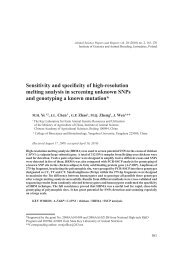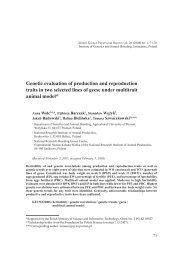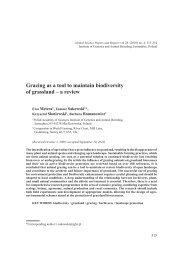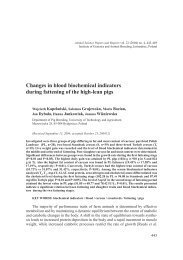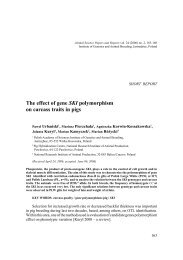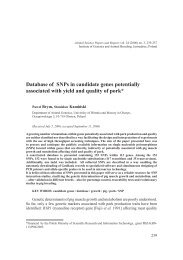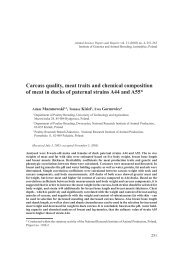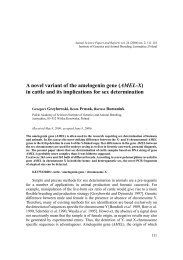SRY-negative, 64,XX sex reversal in a Konik Polski horse: a case ...
SRY-negative, 64,XX sex reversal in a Konik Polski horse: a case ...
SRY-negative, 64,XX sex reversal in a Konik Polski horse: a case ...
Create successful ePaper yourself
Turn your PDF publications into a flip-book with our unique Google optimized e-Paper software.
K. Jaszczak et al.<br />
<strong>negative</strong> <strong>XX</strong> <strong>sex</strong> <strong>reversal</strong> syndrome was reported <strong>in</strong> numerous species of mammals<br />
[Vaiman and Pailhoux 2000]. The syndrome was diagnosed <strong>in</strong> at least 18 can<strong>in</strong>e<br />
breeds [Meyers-Wallen 2006], <strong>in</strong> goats [Pailhoux et al. 2001a], and pigs [Pailhoux et<br />
al.1994, Pailhoux et al. 2001b,c]. Such a type of <strong>in</strong>ter<strong>sex</strong>uality was also recognized <strong>in</strong><br />
several breeds of <strong>horse</strong>s [Milliken et al. 1995, Meyers-Wallen et al. 1997, Bouen et<br />
al. 2000, Vaughan et al. 2001, Bannasch et al. 2007]. It was shown that <strong>SRY</strong>-<strong>negative</strong><br />
<strong>XX</strong> <strong>sex</strong> <strong>reversal</strong> <strong>in</strong> mammals is caused by an autosomal recessive gene and may be<br />
an <strong>in</strong>herited disorder [Buoen et al. 2000]. This report describes one <strong>case</strong> of an <strong>SRY</strong><strong>negative</strong><br />
<strong>XX</strong> <strong>sex</strong> <strong>reversal</strong> <strong>in</strong>ter<strong>sex</strong> phenotype <strong>in</strong> a <strong>Konik</strong> <strong>Polski</strong> <strong>horse</strong> with particular<br />
attention paid to the cytogenetic and molecular genetic aspects.<br />
Material and methods<br />
A three-year-old <strong>Konik</strong> <strong>Polski</strong> <strong>horse</strong> with <strong>sex</strong>ually ambiguous external genitals<br />
and exhibited aggressive stallion-like behaviour was presented for histological,<br />
cytogenetic and molecular <strong>in</strong>vestigations. <strong>Konik</strong> <strong>Polski</strong> <strong>horse</strong>s are a primitive native<br />
breed bred on the basis of a wild <strong>horse</strong> – tarpan. Cl<strong>in</strong>ically the <strong>horse</strong> had mascul<strong>in</strong>e<br />
appearance with the absence of scrotum and possesed ambiguous external genitals.<br />
Penis like clitoris was 7 cm long and protruded from the vulva lips (Photo 1). The<br />
Photo 1. External genitalia of a <strong>64</strong>,<strong>XX</strong> <strong>reversal</strong> <strong>horse</strong>.<br />
urethral orifice was located <strong>in</strong> a female position and ur<strong>in</strong>ation occurred through urethral<br />
fossa at the distal end of the penis. Transrectal ultrasonography to visualize the <strong>in</strong>ternal<br />
parts of reproductive organs and gonads was unreward<strong>in</strong>g, then this, and histological<br />
exam<strong>in</strong>ation were conduced post mortem. Cytogenetic analyses were performed on the<br />
lymphocytes cultured <strong>in</strong> RPMI 1<strong>64</strong>0 medium with pokweed mitogen. Chromosome<br />
preparations were analysed after C-band<strong>in</strong>g [Sumner 1972]. The karyotype was<br />
determ<strong>in</strong>ed based on exam<strong>in</strong>ation of of 200 methaphase spreads (Photo 2).<br />
382



